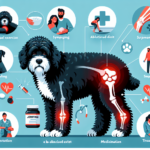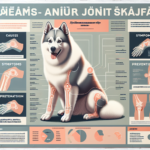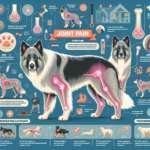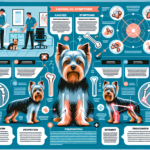Portuguese Water Dog Joint Pain: Causes, Symptoms, Prevention, and Treatment

Introduction
The Portuguese Water Dog is a breed known for its intelligence, agility, and friendly nature. Originating from the Algarve region of Portugal, these dogs were initially bred to assist fishermen by herding fish into nets, retrieving lost tackle, and acting as couriers between ships. With their webbed feet and waterproof coats, they are excellent swimmers and have a high energy level, making them popular in various dog sports and as family pets.
While the Portuguese Water Dog is generally a healthy breed, they are not immune to certain health issues. Common concerns include hip dysplasia, progressive retinal atrophy, and Addison’s disease. Among these, joint pain is a significant issue that can affect their quality of life.
Joint health is particularly crucial for the Portuguese Water Dog due to their active lifestyle and working history. Maintaining healthy joints ensures they can continue to enjoy their activities without pain or discomfort, making it essential for owners to be aware of the causes, symptoms, prevention, and treatment of joint pain in this breed.
Breed-Specific Joint Pain Risks
Genetic Predisposition
The Portuguese Water Dog is genetically predisposed to several joint-related issues, including hip dysplasia, elbow dysplasia, and arthritis. Hip dysplasia is a condition where the hip joint does not fit into the hip socket properly, leading to pain and arthritis over time. Elbow dysplasia involves abnormal development of the elbow joint, causing lameness and discomfort. Arthritis, a degenerative joint disease, can develop as a secondary condition to these dysplasias or independently as the dog ages.
Age-Related Risks
As Portuguese Water Dogs age, the risk of developing joint pain increases. Typically, signs of joint issues may start to appear in middle age, around 5-7 years old. However, some dogs may show symptoms earlier, especially if they have a genetic predisposition. It’s crucial for owners to monitor their dogs for any signs of discomfort as they age and to take preventive measures early on.
Activity Level and Joint Stress
Portuguese Water Dogs are known for their high energy levels and love for physical activities such as swimming, running, and agility training. While regular exercise is essential for their overall health, excessive or high-impact activities can put stress on their joints, leading to wear and tear over time. Owners should balance their dog’s activity levels to ensure they get enough exercise without overburdening their joints.
Common Symptoms of Joint Pain in Portuguese Water Dogs
General Symptoms
Owners should be vigilant for the following common symptoms of joint pain:
- Limping or favoring one leg
- Stiffness, especially after rest or sleep
- Reluctance to jump, run, or climb stairs
- Decreased activity or interest in play
- Swelling around the joints
- Whining or showing signs of discomfort when touched
Breed-Specific Symptoms
In Portuguese Water Dogs, symptoms such as reluctance to swim or perform tasks they previously enjoyed can be more noticeable. Given their history as working dogs, any decrease in their willingness to engage in physical activities should be taken seriously.
When to Consult a Vet
If you notice any of the above symptoms, it’s essential to consult a veterinarian promptly. Early diagnosis and intervention can significantly improve the prognosis and quality of life for your dog. Regular veterinary check-ups are also crucial for early detection of joint issues.
Preventive Measures for Joint Health
Exercise Recommendations
Regular, moderate exercise is vital for maintaining joint health in Portuguese Water Dogs. Activities such as swimming, walking, and controlled play are excellent options. Avoid high-impact exercises like jumping or running on hard surfaces, which can exacerbate joint stress. Consistent, low-impact activities help keep the joints flexible and muscles strong without causing undue strain.
Dietary Suggestions
A balanced diet rich in essential nutrients supports overall health and joint function. Consider incorporating foods or supplements that contain:
- Glucosamine and Chondroitin: These supplements help maintain cartilage health and reduce inflammation.
- Omega-3 Fatty Acids: Found in fish oil, these fatty acids have anti-inflammatory properties that can benefit joint health.
- Antioxidants: Vitamins C and E can help reduce oxidative stress and inflammation in the joints.
Weight Management
Maintaining a healthy weight is crucial for reducing joint stress. Overweight dogs are more prone to joint issues due to the extra load on their joints. Regular exercise and a balanced diet tailored to your dog’s needs can help keep their weight in check. Consult your veterinarian for specific dietary recommendations and portion control.
Early Screening and Monitoring
Early screening for joint issues can help catch problems before they become severe. Regular veterinary check-ups should include joint assessments, especially as your dog ages. Genetic testing for predispositions to conditions like hip and elbow dysplasia can also be beneficial. Monitoring your dog’s activity levels and behavior can provide early clues to potential joint issues.
Treatment Options for Joint Pain
Non-Surgical Treatments
Several non-surgical treatments can help manage joint pain in Portuguese Water Dogs:
- Medications: Non-steroidal anti-inflammatory drugs (NSAIDs) can reduce pain and inflammation. Always consult your vet before administering any medication.
- Physical Therapy: Exercises and therapies designed to improve joint function and reduce pain can be highly effective. Hydrotherapy, in particular, is beneficial for this breed due to their affinity for water.
- Lifestyle Adjustments: Modifying your dog’s activities to reduce joint stress and providing a comfortable living environment can make a significant difference.
Surgical Options
In severe cases, surgical intervention may be necessary. Common surgical options include:
- Hip Replacement: This surgery involves replacing the damaged hip joint with an artificial one, providing significant pain relief and improved mobility.
- Arthroscopy: A minimally invasive procedure used to diagnose and treat joint issues.
- Osteotomy: This surgery involves cutting and realigning bones to improve joint function and reduce pain.
Surgical options should be discussed thoroughly with your veterinarian to determine the best course of action for your dog.
Alternative Therapies
Alternative treatments can complement traditional therapies and provide additional relief:
- Acupuncture: This ancient practice can help reduce pain and improve joint function.
- Hydrotherapy: Water-based exercises can improve mobility and reduce pain without putting stress on the joints.
- Massage: Regular massages can help alleviate muscle tension and improve circulation around the joints.
Lifestyle and Management Tips
Daily Care Routine
A consistent daily care routine can help manage joint pain effectively:
- Provide regular, low-impact exercise such as walking or swimming.
- Administer any prescribed medications or supplements as directed by your vet.
- Monitor your dog’s weight and adjust their diet as needed.
- Incorporate joint-friendly activities and avoid high-impact exercises.
Modifying the Home Environment
Making your home more comfortable for a dog with joint pain can significantly improve their quality of life:
- Use ramps or steps to help your dog access furniture or vehicles.
- Provide orthopedic beds to support their joints while resting.
- Ensure food and water bowls are at a comfortable height to reduce strain.
Long-Term Management
Long-term management strategies are essential for keeping your dog active and happy despite joint pain:
- Regular veterinary check-ups to monitor joint health and adjust treatments as needed.
- Consistent exercise and weight management to reduce joint stress.
- Incorporating alternative therapies like acupuncture or hydrotherapy for additional relief.
FAQs About Portuguese Water Dogs and Joint Pain
What are the early signs of joint pain in Portuguese Water Dogs?
Early signs include limping, stiffness, reluctance to move, and decreased activity levels. If you notice any of these symptoms, consult your veterinarian promptly.
Can joint pain in Portuguese Water Dogs be prevented?
While genetic predispositions cannot be entirely prevented, maintaining a healthy weight, providing regular low-impact exercise, and incorporating joint-friendly nutrients in their diet can help reduce the risk and severity of joint pain.
Are there specific exercises that are better for Portuguese Water Dogs with joint pain?
Yes, low-impact exercises like swimming and walking are ideal. Avoid high-impact activities that can exacerbate joint stress.
What dietary supplements are beneficial for joint health in Portuguese Water Dogs?
Supplements containing glucosamine, chondroitin, and omega-3 fatty acids are beneficial for joint health. Always consult your veterinarian before adding any supplements to your dog’s diet.
When should I consider surgical options for my dog’s joint pain?
Surgical options should be considered when non-surgical treatments are no longer effective, and your dog’s quality of life is significantly impacted. Consult your veterinarian to discuss the best course of action.
Conclusion
Joint pain is a significant concern for Portuguese Water Dogs, but with proper care and attention, it can be managed effectively. By understanding the causes, symptoms, prevention, and treatment options, owners can ensure their dogs lead active, pain-free lives. Regular veterinary check-ups, a balanced diet, appropriate exercise, and early intervention are key to maintaining joint health. Always consult your veterinarian for personalized advice and treatment plans tailored to your dog’s specific needs.




